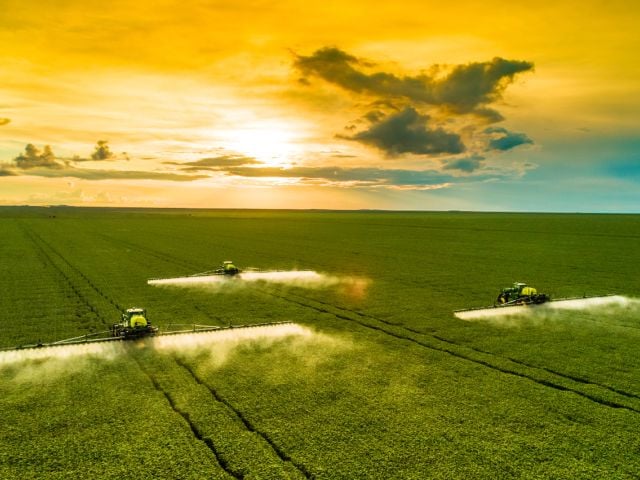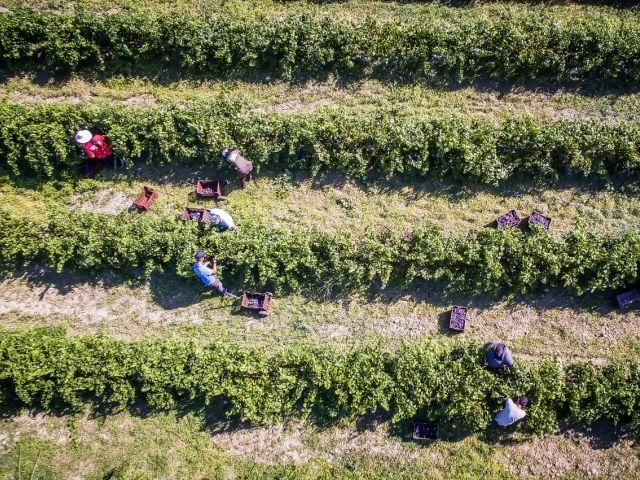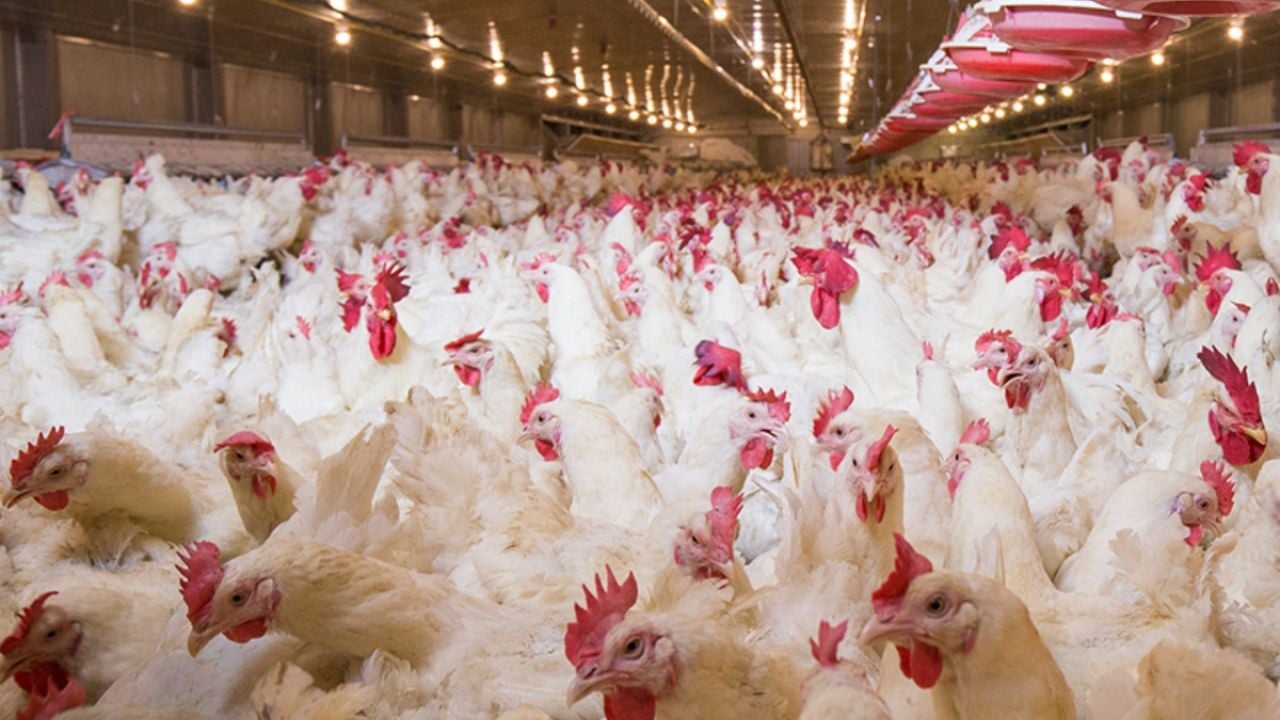
Throughout the U.S., huge facilities raising hundreds or thousands of hogs, poultry or cattle are wreaking havoc on the environment by polluting the air, adding to the climate crisis and contaminating water supplies – with dire consequences for public health.
This pollution is the direct result of cramming such vast amounts of animals in animal feeding operations, typically massive barns or feedlots.
Many of the environmental problems associated with animal facilities come from the manure produced by livestock in these operations. It pollutes public and private sources of drinking water, as well as recreational waters.
Animal operations also damage air quality in nearby communities. Much of this environmental pollution can harm public health by making people sick. It also harms wildlife.
Livestock raised in animal feeding operations also generate methane and nitrous oxide emissions, two gases that add to climate change more than carbon dioxide does.
Cattle burps produce methane emissions, and animal manure releases both methane and nitrous oxide. Feed crops like corn are also a major source of nitrous oxide emissions. The way livestock are currently raised, and the amount produced, contributes to the intensification of the climate crisis and its associated extreme weather.
Major manure pollution
Animal feeding operations are the concentrated facilities and feedlots that produce livestock for meat, eggs and dairy products. In these facilities, hundreds or thousands of cattle, swine, chickens, turkeys, and other animals are raised in large buildings called barns, or, in the case of cattle, in open feedlots.
Confined animal feeding operations, or CAFOs, are the largest of these facilities, which the Environmental Protection Agency regulates, or gives state agencies the power to regulate. CAFOs are operations that contain 1,000 or more animal units, equivalent to 1,000 beef or dairy cows or 2,500 hogs, for example. (See Figure 1.)
Some states, like Minnesota, require animal feeding operations smaller than a CAFO to get a permit to build. But most states do not regulate facilities beyond the EPA’s CAFO requirements, which include a permit to build, operate and maintain the facility, along with a plan describing how the manure will be managed, including disposal.
Figure 1. An Ohio animal feeding operation permitted for almost 1.9 million chickens.
Source: Esri, Maxar, Earthstar Geographics, and the GIS user community.
In the U.S. 99 percent of farm animals are raised in animal feeding operations, also often referred to as factory farms. If you eat meat, it almost certainly came from such a farm.
Factory farms raise significant issues related to animal welfare, farm worker safety and racial justice issues. They’re also extremely bad for public health.
The animals themselves and their manure generate most of the environmental and climate damages associated with factory farms. Animal feeding operations produce a huge amount of manure each year. The animals in Iowa’s largest CAFO facilities alone are responsible for 68 billion pounds of manure each year – 68 times the amount of fecal waste created by Iowa’s entire population of 3.15 million people.
For many swine and dairy cattle operations, manure is stored in liquid form in large pits. (See Figure 2.) To get rid of manure and free up space in the storage pits when they get too full, the manure is sprayed on farm fields to fertilize the soil. Spraying manure on farms is the most common way to dispose of it.
Figure 2. A swine factory farm with a manure pit in North Carolina.
Source: EWG, from Department of Agriculture National Agriculture Imagery Program.
The bedding chickens and turkeys live on in facilities is combined with poultry manure to form “poultry litter.” This mix is also applied to farm fields.
Animal waste is contaminated with dangerous substances like nitrate, total and fecal coliform bacteria, hormones, other pathogens like giardia, pharmaceuticals including antibiotics and heavy metals.
But unlike human waste, animal waste from animal feeding operations is not treated. So it’s applied to farm fields with none of the contaminants removed or lessened. (See Figure 3.)
Figure 3. Manure being sprayed on a farm field.

Source: Shutterstock
When there are very large numbers of animals near each other, concentrated in one or more large facilities, so much manure can be produced that it leads to over-application on nearby fields. Recent Department of Agriculture data show that the largest cattle and chicken facilities have grown in number since 2012, potentially leading to the risk of manure over-application near these operations.
Water quality worries
The contamination livestock manure contains gets into water and air.
Manure and its contaminants pollute water when applied on farm fields, but manure pits can also leak into nearby water sources, like streams or rivers, causing waste spills. Waste can also spill while manure is being transported to a field for application.
The contaminants in manure often run off farm fields after application and pollute nearby waterways. They can also seep through the ground to pollute underground aquifers used for drinking water by owners of private wells.
Drinking water with contaminants from manure is not only repellent but can also be harmful for public health, causing acute health problems like vomiting and diarrhea, and longer-term issues like cancer or birth defects. Manure pollutants from animal feeding operations also contaminate recreational waters, harming public health and wildlife. Phosphorus and nitrogen from manure run off fields into streams and rivers that eventually make their way to larger bodies of water, fueling algae blooms.
These blooms can harm fish and other aquatic wildlife, and they often produce toxins that can be extremely hazardous to people and animals. (See Figure 4.) Exposure to algae toxins for anyone spending time in or near polluted bodies of water can cause respiratory, gastrointestinal, neurologic and skin problems. And some public water systems, like the one in Toledo, Ohio, get their water from a lake or river that can be polluted with algae blooms and toxins, which can also endanger people through drinking water.
Figure 4. An algae bloom in a body of water.

Source: Shutterstock
E. coli and other pathogens from manure can also get into recreational waters, leading to illness as well as beach closures that reduce the amount of time people can enjoy the water. And large spills that involve waste getting dumped directly into bodies of water, can lead to fish kills and other ecological damage.
Air quality and other problems
Livestock facilities also damage air quality, which has public health implications. Pollutants like ammonia, hydrogen sulfide and particulate matter are emitted by animal feeding operations and cause respiratory illnesses like asthma and bronchitis in people living nearby. And studies have found that people who live within a few miles of an animal feeding operation are more likely to die from a cardiovascular problem than people who do not live near an animal facility.
Animal feeding operations also cause harm to public health through pathogen outbreaks on food grown nearby. Multiple outbreaks of E. coli on lettuce have led to illness and death in the past few decades. Irrigation water in canals near animal feeding operations can become contaminated with E. coli and then sprayed on nearby crop fields, or contaminated dust from feedlots can drift onto the fields.
And salmonella was found on cantaloupe in late 2023.
Animal feeding operations also contribute heavily to antibiotic resistance. The overuse of antibiotics in farm animals makes bacteria more resistant and antibiotics less effective, leading to almost 3 million illnesses and 35,000 deaths a year in the U.S.
Greenhouse gas emissions
Agriculture contributes at least 11 percent of U.S. greenhouse gases, and livestock are a major contributor of these emissions. If greenhouse gas emissions from agriculture don’t go down while other industries continue their decreasing trend, this sector could make up 30 percent of U.S. emissions by 2050. (See Figure 5.)
Figure 5: Animation of current and expected U.S. emissions by economic sector (duration 12 seconds).
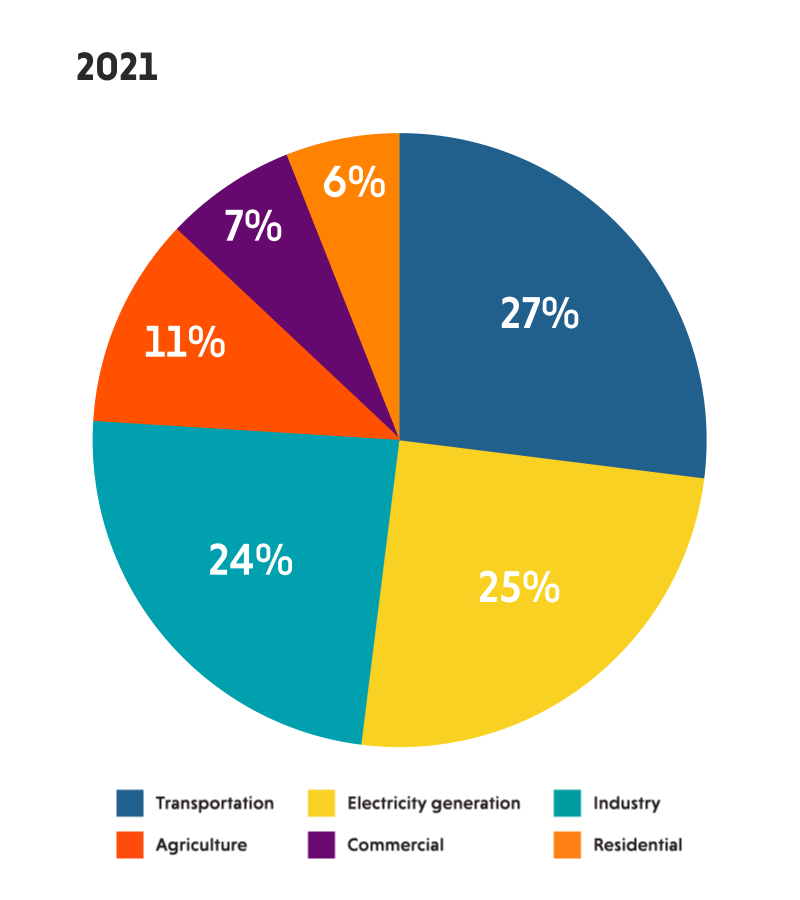
Source: Environmental Protection Agency and Boston Consulting Group
Livestock production mainly creates greenhouse gas emissions directly through cow burps and manure decomposition, and indirectly through agricultural soil management during the growth of livestock feed crops like corn.
The largest source of agricultural emissions is “agricultural soil management,” which produces 49 percent of total U.S. emissions from agriculture. Agricultural soil management is the process farmers use to manage soil when growing crops or using land as pasture for animals.
The way soil gets managed, and therefore the scale of emissions, depends on factors including when, how much, and how fertilizer or manure is applied, if or how much the soil is tilled, what crops are grown, whether crop residue is left on the field after harvest, and whether the soil is drained.
Nitrous oxide is the main greenhouse gas released through agricultural soil management. Emissions from nitrous oxide are tied to livestock because producing animals in facilities or feedlots requires huge amounts of feed, and growing animal feed releases greenhouse gas emissions through agricultural soil management. For example, the use of fertilizer in the production of corn for cattle feed releases nitrous oxide emissions.
Altering the amount, type, placement and timing of fertilizer or manure application could lower emissions significantly. (See Figure 6.) But these changes have not been widely adopted with corn production. For instance, many farmers still apply more nitrogen fertilizer than their crops need, wasting farmers’ money and generating climate emissions.
Figure 6. Fertilizer being sprayed on a crop.
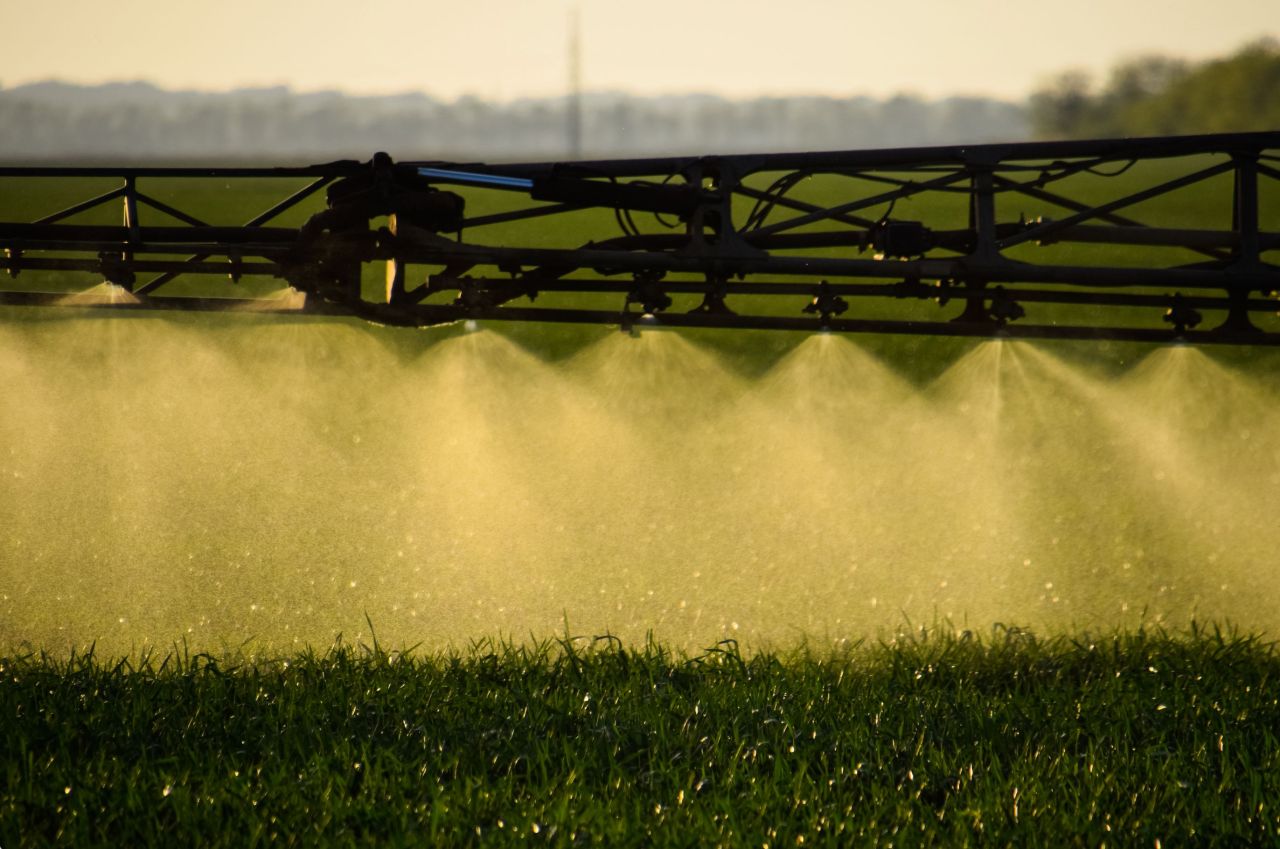
Source: Shutterstock
The main greenhouse gas directly emitted by the production of livestock is methane. It stays in the atmosphere less time than carbon dioxide, but is a stronger greenhouse gas, so it is 28 times more powerful than carbon dioxide over a 100-year period, according to the EPA.
Ruminant animals that have specialized stomachs, as cows do, release methane directly into the atmosphere through their burps. This process is called enteric fermentation and is the source of over 32 percent of all U.S. agriculture emissions.
Cattle operations produce a considerable amount of methane through enteric fermentation. Huge cattle feedlots, like the 115,000-head facility bordered in red in the image below from Yuma County, Ariz., emit a lot of methane. (See Figure 7.) But methane is produced even by cows raised on pasture, rather than in animal feeding operations.
Figure 7. An aerial photo of McElhaney Feedyard in Yuma County, Ariz.
Source: EWG, from Department of Agriculture National Agriculture Imagery Program.
Manure management makes up 11 percent of agriculture’s total greenhouse gas emissions. Methane is released when manure breaks down anaerobically, that is, without oxygen. For instance, the gigantic pits that hog operations in North Carolina use to store manure allow the manure to decompose without oxygen, releasing methane.
Nitrous oxide is produced when the nitrogen in manure evaporates and disperses, and when nitrogen from manure runs off fields into bodies of water or leaches through soil into groundwater.
The ways manure is managed can lower emissions of methane and nitrous oxide.
Manure management includes storage and transport. Wet storage and spreading of manure, common with livestock facilities, produce more emissions than the handling of dry manure. And when manure is naturally put on pasture, as with cattle raised on pastureland instead of in a feedlot, the manure on pasture decomposes with oxygen, leading to hardly any methane emissions.
When it comes to the human diet, meat and animal products generate much more greenhouse gas emissions than other foods. As the chart below shows, beef and dairy cattle produce the most emissions compared to other foods. (See Figure 8.)
Figure 8. Greenhouse gas emissions from different protein sources.
Source: EWG, from “EWG’s Quick Tips for Reducing Your Diet’s Climate Footprint.
A concentration of hundreds or thousands of animals in intensive areas produces pollution that damages our water, air and climate. Contaminants from these facilities, like bacteria, nutrients and particulate matter, threaten public health and hurt wildlife. Reducing the amount of pollution produced by these facilities is critical to protect the environment and climate.
